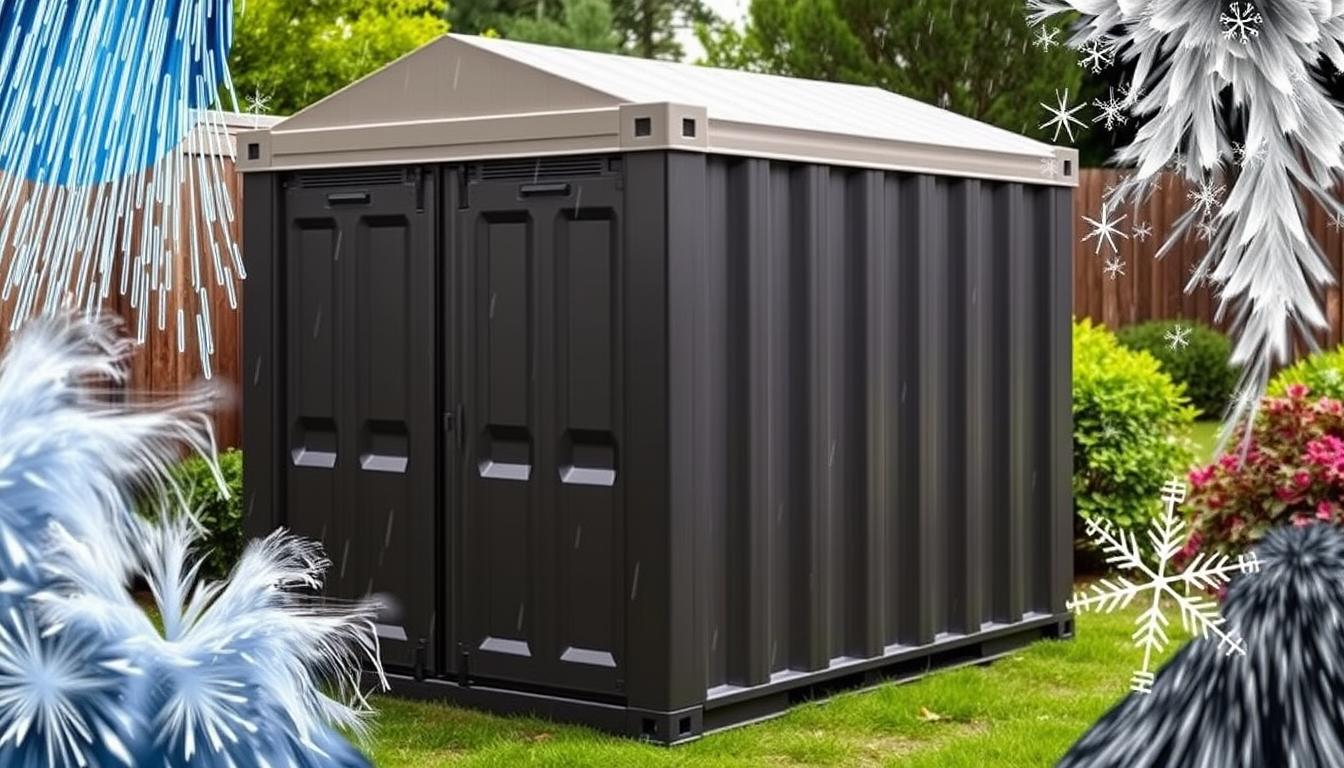Storing items in uncontrolled spaces poses significant risks due to exposure to various environmental factors. These factors can cause substantial damage. Ensuring weather protection is vital to prevent harm from moisture, temperature fluctuations, and other elements. This article will explore effective weather-proof storage solutions to safeguard your belongings.
Moisture control is a critical component of weather-proof storage. Excessive moisture can lead to mold, mildew, and decay. Implementing proper moisture control techniques is essential to keep your items safe and secure. We will discuss the importance of weather-proof storage and offer tips to protect your items from environmental damage.
Key Takeaways
- Weather-proof storage is essential for protecting items from environmental damage
- Moisture control is a critical aspect of weather-proof storage
- Storage protection can be achieved through proper weather-proof storage solutions
- Temperature fluctuations can cause damage to stored items
- Effective weather-proof storage can prevent mold, mildew, and decay
- Proper weather-proof storage techniques can ensure your items remain safe and secure
Understanding Weather-Proof Storage Fundamentals
Storing items in uncontrolled spaces requires climate storage to prevent damage. It’s about setting up the best storage conditions to counteract weather impacts. A critical part of this is humidity control, as too much moisture can cause mold and mildew.
To ensure effective weather-proof storage, understanding environmental factors is key. This includes temperature, humidity, and sunlight exposure. Knowing these elements helps in creating a storage space that keeps items in good condition.
Key Components of Weather Protection
- Waterproofing and water resistance
- Insulation and climate control
- Secure packaging and containment
Environmental Factors to Consider
Factors like temperature changes, humidity, and sunlight can harm stored items. By managing these, one can establish a stable storage area. This protects items from damage.
Common Storage Vulnerabilities
Common issues include bad packaging, poor air flow, and not enough humidity control. Fixing these problems leads to a safer storage space for items.
The Impact of Climate on Stored Items
Climate significantly affects the longevity and condition of stored items. Temperature management is key to maintaining a stable environment. This prevents damage to stored goods. Extreme temperatures can cause items to deteriorate, making climate storage solutions crucial.
Climate can impact stored items in several ways:
- High temperatures can cause items to degrade or become discolored
- Low temperatures can cause items to become brittle or frozen
- Humidity can cause items to become damp or moldy
Effective climate storage solutions can minimize climate-related damage risks. Understanding climate’s impact on stored items helps protect belongings. This ensures they remain in good condition.
Investing in temperature management and climate storage solutions offers peace of mind. Whether for personal or business storage, considering climate impact is vital. It ensures stored goods remain intact and last longer.
Essential Moisture Control Techniques
Moisture control is vital for maintaining optimal storage conditions. Excess moisture can cause mold, mildew, and damage to stored items. It’s essential to control moisture to prevent these issues and ensure the longevity of stored items.
Dehumidification is a primary method of moisture control. It involves removing excess moisture from the air to maintain a stable humidity level. Various methods, such as dehumidifiers, desiccants, or ventilation systems, can be used to control humidity levels.
Dehumidification Methods
- Desiccant dehumidifiers: These use materials like silica gel or activated alumina to absorb moisture from the air.
- Refrigerant dehumidifiers: These use a refrigerant to cool the air, causing the moisture to condense and be removed.
- Ventilation systems: These use fans and vents to circulate air and remove excess moisture.
Alongside dehumidification, ventilation strategies and moisture barriers are also effective. Proper ventilation helps remove excess moisture from the air. Moisture barriers prevent moisture from entering the storage space.
Moisture Barriers and Their Uses
Moisture barriers, such as plastic sheets or waterproof coatings, can prevent moisture from entering the storage space. They are useful in areas with high humidity or where stored items are sensitive to moisture.
| Moisture Control Method | Description | Effectiveness |
|---|---|---|
| Dehumidification | Removes excess moisture from the air | High |
| Ventilation | Removes excess moisture through air circulation | Medium |
| Moisture Barriers | Prevents moisture from entering the storage space | High |
Implementing these moisture control techniques ensures optimal storage conditions and prevents damage to stored items. Regular monitoring of humidity levels and storage conditions is crucial to maintain the effectiveness of these techniques.
Temperature Management Solutions
Effective temperature management is key in climate storage to prevent damage to stored items. Temperature changes can cause warping, cracking, or degradation of materials. It’s vital to maintain a stable temperature. This can be achieved through insulation, climate-controlled storage units, and temperature monitoring systems.
When managing temperature, consider temperature range, humidity levels, and air circulation. Controlling these factors helps create an optimal storage environment. For instance, sensitive electronics need a narrower temperature range than sturdy furniture.
Here are some temperature management solutions to consider:
- Insulation: reduces heat transfer and maintains a stable temperature
- Climate-controlled storage units: provides a consistent temperature and humidity level
- Temperature monitoring systems: tracks temperature fluctuations and alerts you to any changes
By implementing these solutions, your stored items will remain in good condition, regardless of the external climate. This is crucial for items sensitive to temperature changes, like artwork, musical instruments, or pharmaceuticals.
It’s also important to consider the specific temperature requirements of the items you’re storing. Some items need a cool, dry environment, while others require a warm, humid one. Understanding the unique temperature needs of your items allows for a customized temperature management plan.
| Item Type | Temperature Requirement | Humidity Level |
|---|---|---|
| Electronics | 60-70°F (15-21°C) | 40-50% |
| Furniture | 50-60°F (10-15°C) | 30-40% |
| Artwork | 65-75°F (18-24°C) | 50-60% |
Selecting the Right Storage Materials
Choosing the right materials for storage is key. Weather protection and moisture control are vital when picking containers and wrapping materials. The aim is to shield items from environmental damage.
Several weather-resistant container options exist, such as plastic bins, metal containers, and wooden crates. Each has its pros and cons, depending on the items and storage conditions. For instance, plastic bins are light and easy to clean but not ideal for heavy items.
Weather-Resistant Container Options
- Plastic bins: lightweight, easy to clean, and resistant to moisture
- Metal containers: durable, secure, and suitable for heavy or bulky items
- Wooden crates: breathable, eco-friendly, and suitable for storing fragile or sensitive items
Protective wrapping materials also play a crucial role in storage protection. They prevent damage from moisture, dust, and other environmental factors. Popular choices include bubble wrap, foam sheets, and cloth wraps.
Protective Wrapping Materials
Choosing the right wrapping materials depends on the items and storage conditions. Bubble wrap is great for fragile items, while foam sheets are better for heavy items.
| Material | Advantages | Disadvantages |
|---|---|---|
| Bubble wrap | Lightweight, easy to use, and provides excellent cushioning | May not be suitable for heavy or bulky items |
| Foam sheets | Durable, versatile, and provides excellent protection | May be more expensive than other options |
| Cloth wraps | Breathable, eco-friendly, and suitable for storing fragile or sensitive items | May not provide adequate protection for heavy or bulky items |
By focusing on storage protection, weather protection, and moisture control, one can make better choices. This ensures stored items stay safe and the storage space remains organized and efficient.
Specialized Protection for Different Item Types
Storing various items requires careful attention to storage conditions. This is vital for maintaining the quality and longevity of sensitive electronics, artwork, and perishable goods. To prevent damage, controlling the environment is essential. This can be done through humidity control and temperature management systems that keep levels optimal.
Some items demand specific protection, such as:
- Electronics: need a dry environment with stable temperature management to avoid damage from moisture and extreme temperatures.
- Artwork: requires a controlled environment with precise humidity control to prevent damage from moisture and mold.
- Perishable goods: need a cool, dry environment with proper storage conditions to maintain their freshness and quality.
Understanding the specific needs of each item type is crucial. Implementing the right storage conditions, humidity control, and temperature management
Monitoring and Maintaining Storage Conditions
Keeping stored items in good condition requires proper storage conditions. It’s vital to monitor and maintain optimal conditions, including humidity and temperature control. This ensures items are not damaged by extreme conditions.
Regularly checking temperature and humidity levels is key to effective storage. Temperature tracking tools help monitor temperature changes. Humidity monitoring systems detect humidity level shifts. These tools enable individuals to maintain ideal storage conditions, safeguarding their items.
Tools for Monitoring Storage Conditions
- Temperature tracking tools, such as thermometers and temperature loggers
- Humidity monitoring systems, including hygrometers and humidity sensors
- Maintenance schedules to ensure regular checks on storage conditions
Regular maintenance is crucial for the long-term preservation of stored items. By focusing on humidity control and temperature management, individuals can protect their items. This approach ensures optimal storage conditions.
Common Weather-Related Storage Challenges
When storing items, weather protection is key to avoid damage from nature. Flooding, extreme temperatures, and humidity are common issues. They can be managed with the right storage protection methods.
Some frequent weather-related storage problems include:
- Flooding: which can cause water damage and mold growth
- Extreme temperatures: which can cause items to degrade or become brittle
- Humidity issues: which can lead to moisture control problems and damage to sensitive items
To tackle these issues, effective weather protection and storage protection are crucial. This includes using waterproof containers, dehumidifiers, and climate-controlled storage. These measures help keep your items safe, even in harsh weather.
Cost-Effective Weather-Proofing Strategies
Investing in climate storage solutions is a smart move to protect your items from the elements. By managing storage conditions, like humidity, you can prevent damage and prolong your belongings’ life. This section will dive into cost-effective weather-proofing strategies to optimize your storage space.
Weather-proofing can be tackled through DIY methods or professional services. Affordable options include waterproof containers, sealing gaps, and maintaining a steady temperature. These steps help create a safe space for your items, no matter the climate or storage conditions.
Some effective, budget-friendly strategies include:
- Using desiccants to control humidity
- Installing shelving and racks to maximize storage space
- Utilizing waterproof bags and containers
Investing in these methods can safeguard your items from environmental damage. It’s crucial to assess your specific storage needs and climate when choosing a strategy. If needed, don’t hesitate to seek professional advice.
Proactive weather-proofing can save you time and money over the long haul. Whether opting for DIY or professional solutions, the goal is to find a method that suits your storage requirements. With the right approach, you can ensure a safe environment for your items, regardless of the climate or storage conditions.
| Strategy | Cost | Effectiveness |
|---|---|---|
| DIY Solutions | Low | Medium |
| Professional Options | High | High |
| Climate Storage Solutions | Medium | High |
Seasonal Storage Adaptations
As seasons shift, adjusting your storage methods is key to safeguarding your items. Temperature management is vital for preserving the quality of your stored goods. Summer’s heat can harm sensitive items, while winter’s cold can lead to moisture and mold.
Implementing climate storage solutions tailored to each season’s unique conditions is crucial. Using breathable materials and maintaining a steady temperature can prevent damage from extreme weather.
Here are some seasonal storage adaptations to consider:
- Summer: Employ storage protection techniques like shading and ventilation to combat heat and moisture.
- Winter: Insulate your storage space to keep temperatures stable and block cold air.
- Spring and Fall: Keep an eye on humidity and adjust your storage plans to avoid moisture damage.
By integrating these seasonal adjustments into your storage plan, you can protect your items for the long haul. This ensures their value remains intact.
| Season | Storage Adaptations |
|---|---|
| Summer | Shading, ventilation, breathable storage materials |
| Winter | Insulation, consistent temperature maintenance |
| Spring and Fall | Humidity monitoring, moisture-control measures |
Conclusion: Ensuring Long-Term Protection for Your Stored Items
In this detailed guide, we’ve highlighted the critical role of weather protection and storage protection in safeguarding your precious belongings. Understanding the importance of moisture control, temperature management, and the use of specialized storage materials is key. This knowledge helps in preserving your items, whether they’re in a garage, basement, or other spaces not designed for storage.
Effective weather-proof storage hinges on proactive planning and consistent maintenance. It’s crucial to regularly check temperature and humidity levels. Implementing the correct protective measures and adjusting your storage strategies with the seasons can significantly enhance protection. By adopting these strategies, you can ensure your items remain safe from weather damage, maintaining their value and condition over time.


